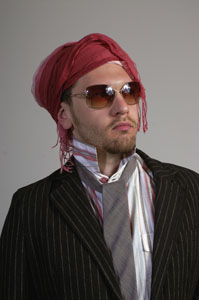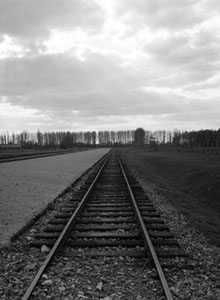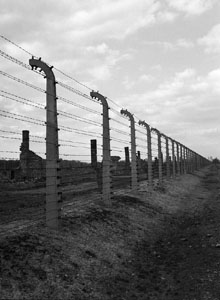I’ve been fascinated by photography for sometime. In particular I like trying to capture moments of movement and darkness that cameras and eyes usually never get.
But sometimes you get bored, don’t want to drag along a camera and look for another way to express some creativity. Most of my progress reports at Detroit Country Day School focused on similar theme,
"Mark is a hard worker, blah, blah, but needs to focus more on his studies and less on drawing during class…blah, blah, blah."
So lately I’ve been getting back to my roots. Those long tentacles that have been developing in school since I could pick up a pencil. Drawing, the first artistic love of my life.
I used to draw in every class from History to Math, even Graduate level Colloid Science. For some reason the professor didn’t appreciate this very much. When I asked him what I could do to improve my understanding of colloids he cited my sleeping in class and attention to sketches as evidence that I was a poor student. Of course, he was oblivious to the fact that the woman sitting behind me drew more often and far more elaborately during his PowerPoint lectures than I ever did.
In reality I draw in class to keep the visual centers of my mind occupied, and to balance the resources needed to retain information in the long-term memory banks. As the keen reader might imagine, my teachers have never really understood or cared about this technique.
Back to the recent past, I took in two concerts recently: Kosheen and Juliette Lewis. My cameras stayed at home while I sketched the events as they occurred – true Gonzo Sketching Journalism.
Kosheen is an electronic-themed singer from the UK. The music is something like relaxed Jazz feeling a-la techno music experience. Her show on Wed. April 18th was in the Zurich Volkshaus venue. It’s close to Helvetia Platz, just a stones throw from Xenix and only a few blocks from the strip joints on Langstrasse, the Red Light District of Zurich.
Volkshaus has a nice theater-like setup. The lobby entrance includes bouncers and a bar. Walk through the doors and you’re on the main floor with the stage at the end of the room. Sometimes you want to dance in-front of the stage, sometimes you just want to relax and enjoy the experience. We went upstairs to the balcony section where we had free roam of unreserved wood seating. Hanging from the ceiling was grand chandelier-type lighting.

I like having choices in life, Volkshaus is a cool venue because you can be part of the show on the floor or just chill by the roof rafters. The balcony also gave a nice vantage point for sketching. On the floor the action would have been moving too fast to draw anything, but in the thin air I could sit back and let the scene materialize on the paper.
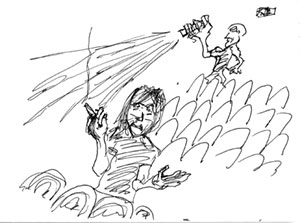
It felt good getting back to my drawing roots. Unless you’re taking a high-quality camera to the show, your photos will most likely turning out looking black with some detail of the people on-stage. By sketching the scene you can make things as clear or obscure as you like, add whatever elements are needed and leave out the distracting ones. Plus, it makes you look at photo subjects in a different way, combining this slow exposure technique with your photographic vision helps develop an eye for the interesting elements of a scene which your pocket digital camera would have probably glossed over.
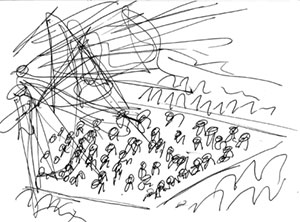
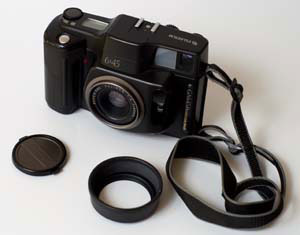 If you define a professional camera as one that actually says professional on it, then the Fuji GA645 was my first pro caliber photo tool. When first released in the early 1990’s it went for something near to 1500 USD. Now they are commonly found on eBay for 300-500 USD. For professionals it means a camera with near point-and-shoot convince and killer tack-sharp medium format “pop”. It really is point-and-shoot. You depress the shutter button half-way, it focuses, depress further, it takes the picture. Given its geometry and size, the GA645 is easy to hold steady in low-light situations. As I mainly do travel and landscape with this camera. The lens is a 60mm Fujion with an f/4 aperture. Many people have found fault with this design, complaining that f/4 is just too slow, the same people who have shot down the Sigma DP1, which sports an f/4 objective. Of course, numbers on paper are just that, in practice I haven’t found the f/4 lens to be limiting. Toss in some ISO 400 or 800 speed film and you have the ability to shoot in low-light situations, and since you’re shooting with a 6×4.5 film size, the quality of the resulting image will still be fantastic, especially for such a mobile camera design. The automatic focus however, can be a bit frustrating. Every camera has limitations, and the autofocus is what adds a rain-cloud texture to the overall fantastically sunny experience of shooting with a GA645. See, once in a while I get my negatives or transparencies back and find the subject was out of focus and blurry. For this reason, in general the GA645 is best used for static subjects. The focus distance is displayed in the viewfinder, so you can always look there to make sure it’s about right. It’s also possible to do manual focusing, which is nice because the focus was easily fooled when I traversed from Bettmerhorn to Eggishorn in intermittent fog cover in the Swiss Alps. Shooting into the rising sun can also screw with the focus system, and in such situations I set the focus to infinity. Despite the autofocus limitations, the metering system is dead-on and I rarely have any exposure problems.
If you define a professional camera as one that actually says professional on it, then the Fuji GA645 was my first pro caliber photo tool. When first released in the early 1990’s it went for something near to 1500 USD. Now they are commonly found on eBay for 300-500 USD. For professionals it means a camera with near point-and-shoot convince and killer tack-sharp medium format “pop”. It really is point-and-shoot. You depress the shutter button half-way, it focuses, depress further, it takes the picture. Given its geometry and size, the GA645 is easy to hold steady in low-light situations. As I mainly do travel and landscape with this camera. The lens is a 60mm Fujion with an f/4 aperture. Many people have found fault with this design, complaining that f/4 is just too slow, the same people who have shot down the Sigma DP1, which sports an f/4 objective. Of course, numbers on paper are just that, in practice I haven’t found the f/4 lens to be limiting. Toss in some ISO 400 or 800 speed film and you have the ability to shoot in low-light situations, and since you’re shooting with a 6×4.5 film size, the quality of the resulting image will still be fantastic, especially for such a mobile camera design. The automatic focus however, can be a bit frustrating. Every camera has limitations, and the autofocus is what adds a rain-cloud texture to the overall fantastically sunny experience of shooting with a GA645. See, once in a while I get my negatives or transparencies back and find the subject was out of focus and blurry. For this reason, in general the GA645 is best used for static subjects. The focus distance is displayed in the viewfinder, so you can always look there to make sure it’s about right. It’s also possible to do manual focusing, which is nice because the focus was easily fooled when I traversed from Bettmerhorn to Eggishorn in intermittent fog cover in the Swiss Alps. Shooting into the rising sun can also screw with the focus system, and in such situations I set the focus to infinity. Despite the autofocus limitations, the metering system is dead-on and I rarely have any exposure problems.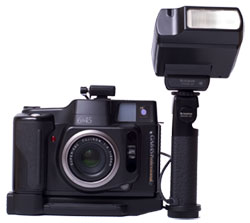 The Fuji GA line sports a few accessories, which one is still able to pick up if one is so inclined. A flash bracket and flash we produced, the basic GA bracket is shown here. Somehow I’ve acquired one bracket and two flashes, both of which I never actually use with my GA645. If you do use them however, the flash exposes very nicely with a butter popping sound. The bracket has a tilting head, so when you rotate the camera to shoot in landscape orientation, you can rotate the flash 90 degrees (similar to the Sony HVL-58). I sometimes use the bracket with my Minolta 7D. Since neither is produced anymore, they can be had on the used market for either reasonable or absurd prices. The one useful accessory I do use often is the tripod bracket. It lets you mount the camera and rotate around the axis of the lens, perfectly balanced and engineered. A macro attachment is also available, but doing macro work without being able to check the actual focus is bit hit and miss – and with medium format film, a tad expensive.
The Fuji GA line sports a few accessories, which one is still able to pick up if one is so inclined. A flash bracket and flash we produced, the basic GA bracket is shown here. Somehow I’ve acquired one bracket and two flashes, both of which I never actually use with my GA645. If you do use them however, the flash exposes very nicely with a butter popping sound. The bracket has a tilting head, so when you rotate the camera to shoot in landscape orientation, you can rotate the flash 90 degrees (similar to the Sony HVL-58). I sometimes use the bracket with my Minolta 7D. Since neither is produced anymore, they can be had on the used market for either reasonable or absurd prices. The one useful accessory I do use often is the tripod bracket. It lets you mount the camera and rotate around the axis of the lens, perfectly balanced and engineered. A macro attachment is also available, but doing macro work without being able to check the actual focus is bit hit and miss – and with medium format film, a tad expensive.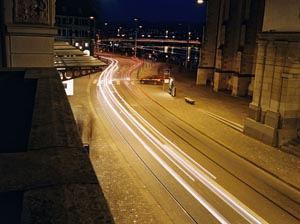

 The general risk with buying old discontinued Pro technology is that, if it breaks – you’re screwed. So it’s actually sort of cool that you can still send in the GA645 to Fuji for a tune-up. About two years ago I picked up some surplus GA645 parts from eBay, including some shutters and body pieces, so aside from Fuji, I’m somewhat confident I could fix basic problems should they arise. The Fuji GA line is just the start, you can also get into the GW and GSW cameras, which can be bough in 6×7, 6×8, and 6×9 versions, all offering jaw-dropping razon tack-sharp images. So getting down to Brass-Tax, in the age of digital sensors and megapixels the Fuji GA645 is a film camera which still rocks hardcore. If you have some spar funds I highly recommend picking one up.
The general risk with buying old discontinued Pro technology is that, if it breaks – you’re screwed. So it’s actually sort of cool that you can still send in the GA645 to Fuji for a tune-up. About two years ago I picked up some surplus GA645 parts from eBay, including some shutters and body pieces, so aside from Fuji, I’m somewhat confident I could fix basic problems should they arise. The Fuji GA line is just the start, you can also get into the GW and GSW cameras, which can be bough in 6×7, 6×8, and 6×9 versions, all offering jaw-dropping razon tack-sharp images. So getting down to Brass-Tax, in the age of digital sensors and megapixels the Fuji GA645 is a film camera which still rocks hardcore. If you have some spar funds I highly recommend picking one up.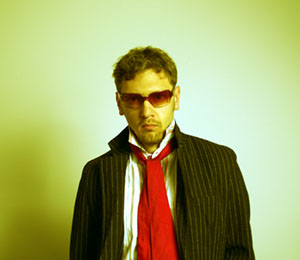 Spend five seconds on any photography forum and the topic of Going Pro eventually comes up. The premise is rather simple: someone takes up photography as a hobby, decides they like taking photos, realize that they can produce images similar to those of professional photographers, and want to become a professional themselves.
Spend five seconds on any photography forum and the topic of Going Pro eventually comes up. The premise is rather simple: someone takes up photography as a hobby, decides they like taking photos, realize that they can produce images similar to those of professional photographers, and want to become a professional themselves. However, without his client list, reputation, and inter-personal skills, my ability to do his job is severely reduced. As a photographer, this doesn’t really mean much to me, as I’m more interested in developing my own look, just like I developed my own writing voice and interpretation on project management techniques and problem solving. This is not to say that amateurs shouldn’t be making money off of photography, but start small – and begin with a plan for profits. Figure out what you want to do and form an economically feasible strategy around it. If you have a thousand images, don’t just blindly sent them off to istock.com, figure out a stock photo niche and build around it. I think that integrating economic principles into creative fields and a hobby like photography is overall a good thing. The world runs on economic systems, and trying to imply that they don’t exist and that creativity and art and photography are pure forms of expression untainted by the complications of money is in some ways a tad short-sighted. Life is a crazy adventure, be fresh, explore new ideas and possibilities, but if you’re primarily interested in fulfilling your life via the integration of creativity, don’t blindly buy into the rumor that becoming a professional in the field of photography will solve anything or actually be a good idea.
However, without his client list, reputation, and inter-personal skills, my ability to do his job is severely reduced. As a photographer, this doesn’t really mean much to me, as I’m more interested in developing my own look, just like I developed my own writing voice and interpretation on project management techniques and problem solving. This is not to say that amateurs shouldn’t be making money off of photography, but start small – and begin with a plan for profits. Figure out what you want to do and form an economically feasible strategy around it. If you have a thousand images, don’t just blindly sent them off to istock.com, figure out a stock photo niche and build around it. I think that integrating economic principles into creative fields and a hobby like photography is overall a good thing. The world runs on economic systems, and trying to imply that they don’t exist and that creativity and art and photography are pure forms of expression untainted by the complications of money is in some ways a tad short-sighted. Life is a crazy adventure, be fresh, explore new ideas and possibilities, but if you’re primarily interested in fulfilling your life via the integration of creativity, don’t blindly buy into the rumor that becoming a professional in the field of photography will solve anything or actually be a good idea.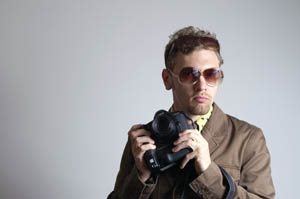 I’m an engineer, which means that although I search for Zen, I am forever bound to the material attraction of gadgets and toys. My camera collection includes a Woca (Holga), Minolta 7, Minolta 7D, Fuji GA645, Contax G1, and my very first digital: the Canon D2000 (Kodak DCS520). The D2000 was the Canon version of a co-development between Kodak and Canon to produce the first real Digital Single Lens Reflex (DSLR) camera. Kodak did the sensor and Canon provided the camera body technology. It’s true, there were predecessors, the Kodak-Nikon did come first with the DCS420, but the digital back and camera body really weren’t integrated, and it didn’t even sport an LCD on the back. The D2000/DCS520 displays integrated digital-camera body technology with a LCD and the large adjustment wheel, which is still standard on every pro-level Canon and even on the top-of-the-line G7. All subsequent pro-level Canons have their routes in the D2000/DCS520.
I’m an engineer, which means that although I search for Zen, I am forever bound to the material attraction of gadgets and toys. My camera collection includes a Woca (Holga), Minolta 7, Minolta 7D, Fuji GA645, Contax G1, and my very first digital: the Canon D2000 (Kodak DCS520). The D2000 was the Canon version of a co-development between Kodak and Canon to produce the first real Digital Single Lens Reflex (DSLR) camera. Kodak did the sensor and Canon provided the camera body technology. It’s true, there were predecessors, the Kodak-Nikon did come first with the DCS420, but the digital back and camera body really weren’t integrated, and it didn’t even sport an LCD on the back. The D2000/DCS520 displays integrated digital-camera body technology with a LCD and the large adjustment wheel, which is still standard on every pro-level Canon and even on the top-of-the-line G7. All subsequent pro-level Canons have their routes in the D2000/DCS520.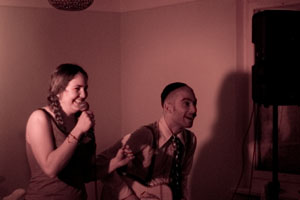 In 1993 the D2000/DCS520 retailed for something on the order of $15,000. Built on the supposedly fantastic Canon 1N film body the D2000 sports a vertical grip, EOS lens mount, first-rate viewfinder and 2 Mega-Pixel APS sensor. Yes, two Mega-Pixels, by modern digital camera marketing number standards this is no better than a crap camera phone. But the keen engineer-gadget-freak looks beyond hollow numbers to the buried beauty inside. The D2000/DCS520 can be found for something like $300-$500 on eBay (depending on what else is included). For my D2000 I picked up the cheap-but-killer-awesome Canon 50 mm f1.7 lens (~$80). With the battery the D2000 is a bit of a brick to hold in the hand. However, there are some cool advantages to owning near 10 year-old pro digital camera technology (from the product research and development time, it may be closer to 20 years old).
In 1993 the D2000/DCS520 retailed for something on the order of $15,000. Built on the supposedly fantastic Canon 1N film body the D2000 sports a vertical grip, EOS lens mount, first-rate viewfinder and 2 Mega-Pixel APS sensor. Yes, two Mega-Pixels, by modern digital camera marketing number standards this is no better than a crap camera phone. But the keen engineer-gadget-freak looks beyond hollow numbers to the buried beauty inside. The D2000/DCS520 can be found for something like $300-$500 on eBay (depending on what else is included). For my D2000 I picked up the cheap-but-killer-awesome Canon 50 mm f1.7 lens (~$80). With the battery the D2000 is a bit of a brick to hold in the hand. However, there are some cool advantages to owning near 10 year-old pro digital camera technology (from the product research and development time, it may be closer to 20 years old).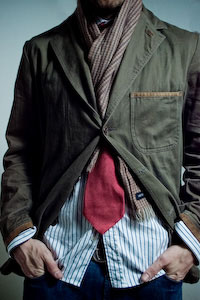 You can shoot in JPEG but I always shoot raw. At 2 Mb per raw file you can enjoy all the raw benefits and not fill up your hard-drive. I love shooting raw with my Minolta 7D, but at 8.1 megs per raw file, the small 60 gig drive on my G4 PowerBook only holds so much. The size of a camera sensor pixel translates to it’s ability to interact with light. So point-and-shoot cameras with high mega-pixel counts and very small pixel sizes produce images which look clean, but generally flat because the sensor pixel size is not large enough to effectively capture the light hitting the sensor (at least this has been my observation). Conversely, multi-ten-thousand dollar medium format digital backs generally render deeper, richer colors, due in part to their larger pixel size. In fact, the keen camera fool might note that the 2 megapixel APS-sized sensor retains a pixel pitch of 11.9 microns. In the age of megapixel marketing driven mania it is interesting to note that this pixel pitch is larger than that of the $2500 Canon 5D, the $16,000 Canon Mark-IIn, or even many of the $25,000 medium format digital backs. If you add a large flash the camera is a tad too big to carry around in normal settings. But when the lighting is right the results can be fantastic. For controlled lighting work, like with off-camera strobes (check out
You can shoot in JPEG but I always shoot raw. At 2 Mb per raw file you can enjoy all the raw benefits and not fill up your hard-drive. I love shooting raw with my Minolta 7D, but at 8.1 megs per raw file, the small 60 gig drive on my G4 PowerBook only holds so much. The size of a camera sensor pixel translates to it’s ability to interact with light. So point-and-shoot cameras with high mega-pixel counts and very small pixel sizes produce images which look clean, but generally flat because the sensor pixel size is not large enough to effectively capture the light hitting the sensor (at least this has been my observation). Conversely, multi-ten-thousand dollar medium format digital backs generally render deeper, richer colors, due in part to their larger pixel size. In fact, the keen camera fool might note that the 2 megapixel APS-sized sensor retains a pixel pitch of 11.9 microns. In the age of megapixel marketing driven mania it is interesting to note that this pixel pitch is larger than that of the $2500 Canon 5D, the $16,000 Canon Mark-IIn, or even many of the $25,000 medium format digital backs. If you add a large flash the camera is a tad too big to carry around in normal settings. But when the lighting is right the results can be fantastic. For controlled lighting work, like with off-camera strobes (check out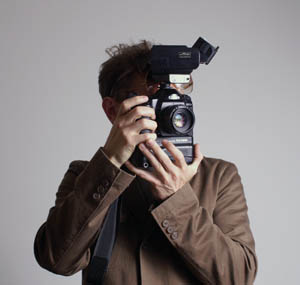
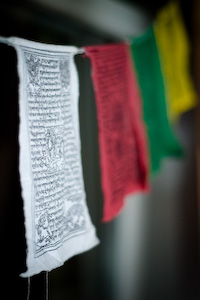
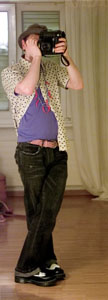 Plus, and this is important, the D2000 is a killer party camera – maybe not so much for the club night or bar hop, it’s too big for those gigs. However, the D2000 is awesome in a festive setting and works best at costume affairs or dinner parties. It just looks cool to carry a large camera around these circles. If it’s a costume party and you go with a Hunter S. Thompson theme, the Canon D2000 will no doubt boost your Gonzo-reporter flare. I reviewed the limitations of the D2000/DCS520 before buying it, and the purpose in doing so was mainly as a learning camera. It has all the features of a pro-body, but with a learning curve which guarantees you’ll gain a unique education in digital photography. But after using it on and off for two years I have to say I prefer it in some situations due to the limitations which, like those of a Holga, I’ve become quite fond of. Further reading at
Plus, and this is important, the D2000 is a killer party camera – maybe not so much for the club night or bar hop, it’s too big for those gigs. However, the D2000 is awesome in a festive setting and works best at costume affairs or dinner parties. It just looks cool to carry a large camera around these circles. If it’s a costume party and you go with a Hunter S. Thompson theme, the Canon D2000 will no doubt boost your Gonzo-reporter flare. I reviewed the limitations of the D2000/DCS520 before buying it, and the purpose in doing so was mainly as a learning camera. It has all the features of a pro-body, but with a learning curve which guarantees you’ll gain a unique education in digital photography. But after using it on and off for two years I have to say I prefer it in some situations due to the limitations which, like those of a Holga, I’ve become quite fond of. Further reading at 